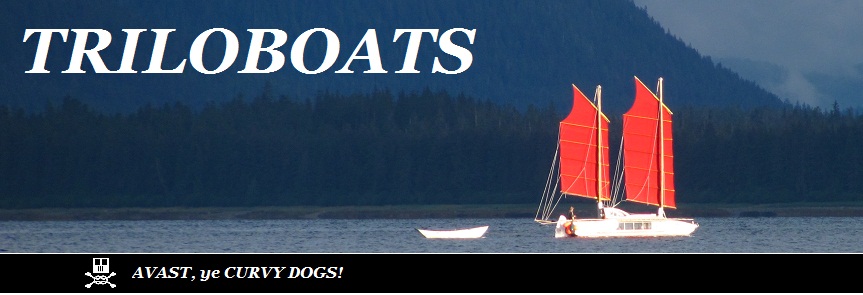 |
| Our Knives currently in service On Board and at the Work Site |
Son,
when ya gotcher bollocks snarled o' the mainsheets, 'tis no time to
be fumblin' in yer pocket fer a knife!
-- Old Salt
Advocating a Sheath Knife in Characteristically Declarative Form
Good
Knife, Bad Knife
The Good Knife has been a boon to our
species since the first flint was napped. A keen edge and stout blade
have been the sailor's friend since the first line was spliced. To a
boatwright, it's the first tool in hand and the last to be set aside.
Its edge is the stuff of legend...
forged in the fires of Vulcan hisself, it must only be sharpened on
stones quarried by the full moon, using potent unguents,
trigonometries and incantations. It's virtue must be guarded against
the coarseness of base matter and the corruption of oxidation.
Purified and preserved, it may be drawn in the day of need to slay
the Dragon.
Ahem.
Hyperbole aside, a Good Knife can mark,
slice, part, shave and – in a pinch – perform minor surgery. Its
virtues and minutia are compared and contrasted down to the least
degree. It's design and creation are the hallmarks of art and
mastery.
But the BAD Knife... who has sung its
praises? What sailor hath come forth to speak on its behalf? Plenty with high standards come forth to diss it. Life's too short, and all that. Well,
here once again, to give voice to the down-trodden...
Since my early days as a sea-faring
wood-butcher, I've carried two knives on my belt. One is a Good
Knife, and the other Bad.
The Bad Knife, as you might expect,
handles the dirty work. You know... scraping paint, cleaning fouled
screw threads, cutting cardboard patterns, excavating a fastener,
paring wood of dubious provenance, cutting down to a metal backstop,
working around glue, a cautious bit of prying, working where a bump
or slip will send it to Davey Jone's... in short, 99% of the jobs
around the water.
The Bad Knife is the
jack-of-all-trades. Johnny-on-the-spot. The tool at hand that saves
you that return trip up and out of the bilge, down a ladder to
rummage through the toolbox for that specialized tool that claim to
do a momentary job a mere fraction of a bit better. The Bad Knife
sneers at all those sissified tools populating those glossy
catalogues. Sniggers at that prissy Good Knife, come to that.
It's got to be cheap. One step up from
disposable. If possible, bought in quantity. If you don't run through
them, so much the better. If you do, a Zen/Amazon non-attachment is a
fine thing (AmaZen?).
It needs to be able to take a
reasonable edge without putting too much time into it. Zip, zap
and git 'er did. If it takes more than five minutes to restore
the edge, it's too hard, and treading on the Good Knife's territory.
Forget about removing minor nicks and notches. If it has to be
sharpened more than once a week (barring the occasional, kamikaze
mission), it's too soft.
Or thereabouts... your call. Point is,
its steel must be bad enough to abuse, but not so bad it's useless.
Where those endpoints lie is up to you.
A thickish blade is fine, in theory, as
we'll want to beat on it, often with a hammer or axe. But we're most
of us sailing small boats, so we won't be parting giant hawsers.
Unless we want to chop the mast down with our blade, a thin-ish one
will do. A little less than 1/8th inch (3mm) has been
plenty for all I've ever asked of them.
For the Bad Knife, I've personally come
to like full-tang, drop-tip style, without handle cheeks and no serration. This type
lies flat and unobtrusive as possible... easier to wear without
hanging up on every durn thing, and to stow several cheek-on-jowl If
it comes with a paracord wrap, I don't take it off, but if not, I
don't add it. All things being equal, a simple handle is cheaper
without the extra materials and labor costs.
Two blades of a single make can be
used, one designated as Good, the other Bad. In this case, I'd err on
the side of better steel. I can live with abusing a hard edge, but
not with abuse from a soft one! Seriously, a dull blade is
dangerous... we're looking for one that can stand up reasonably well
to insult and injury.
Ironically, the humble sheath merits
more mention than it generally receives.
Personally, I like to make one
sheath to fit my standard Good Knife, Bad Knife and marlinespike. I
like one sheathed inboard and riding a bit high; the other outboard
and a bit lower... enough difference that I can pull my choice by
feel alone. In-line works okay, too, with relatively slender blades.
I like the marlinespike aft. All three snugly fit to expose only
enough 'hook' to get a good finger grip on it. If one has handle
cheeks, it goes outboard. If the handle has no hook at its handle
end, I like to add one (don't care for lanyards which hang up).
I like to wear it just aft of my hip
blade on the strong arm side. Not so far back I sit on it, but far
enough that it doesn't get between me and my hip when I'm working on
my side. This is more comfortable, and I can still access it from
behind. A stiff belt and loop help keep it in place and from
flopping.
In practice... I'm between custom
sheaths at the prolonged moment, making do with the wretched
contraptions contrapted by those who sell the knives. They're just
tolerable enough to keep replacing them off any given day's priority.
But that's no praise at all.
Any knife with a bad sheath is at best
compromised; at worst dangerous.
* * * * *
A Few Bargain Knives
All the knives listed here are
inexpensive. 'Gooder' knives can be had, but they cost enough that
you would NOT want to lose one overboard. Remember, too... the harder
the steel, the more time and trouble spent attaining and maintaining
its edge in mixed use!
(Frost) Mora – From Mora
Sweden, this line includes mostly Sloyd pattern knives (drop tip on a
slender profile; good shape for carving and general) with a narrow,
full-length tang. Made for carving, hunting and the fishing
industry. Models with laminated blades are exceptional, with a very
hard layer sandwiched between two softer layers. This takes a
great
edge... it is therefore somewhat brittle. The softer layers support
the blade as a whole.
Mora knives were once dirt cheap... no
longer, but still a bargain. The laminated blades, especially, put a
top-of-the-line edge in our hands for cheap (about US$25 as I write).
Blanks are often available, but can cost as much or more than the
finished knife. Their sheaths vary, but I don't care for any they
provide.
The laminated Mora in the leading
picture is my Good Knife of choice..
Old Hickory and Ontario – These and similar are
generally sold as kitchen knives, and some of their paring knives
come in handy sizes with full tang. Larger styles can be treated as
blanks to shape your own. Relatively inexpensive and made with
high-carbon steel, they can handle most jobs with ease. No sheaths.
Opinel – A French
shepherd's knife, these are inexpensive, locking folders (Anke likes
them; they're a little bulky for my taste). High carbon steel for a
good edge, but the lack of any tang leaves them a shade delicate.
Schrade OLD TIMER Barlow
– This is a folding knife well-made to a pattern that combines a
general purpose blade with a carving blade in a compact,
pocket-friendly shape. It sells cheap enough (about US$15 as I write... cheaper at other vendors) that we get extras as first-knife gifts for children whose
parents deem them ready. My only quibble is that they don't have
locking blades (nor do any other Barlows I've seen).
For boat-work, it handles the fine end
of things that a bigger knife finds clumsy.
US Custom Design SURVIVOR
– Dedicated Bad Knife... easily takes an okay edge but won't hold
it long. These run about US$7.00 and come in several styles including
drop-point (shown) and tanto. The style shown carries a
full-thickness back 2/3rds of its length... this takes more abuse
than styes which taper the whole length. I file the sharp corners and
- if I get around to it - I'll grind off those finger guards. But
quite usable as is.
Tiny print declares them to be “hand
forged in China”, but 'forged' is stretching it. Cheap Chinese
goods can vary wildly in quality, but so far, the batch we got is
just about right. Webbing sheath... works. but barely.
Knives of this sort abound, and I did
some spelunking around before I found this brand. Nothing too special
about them. But be aware that many of these cheap-o's tend to dull at
the first swipe. If you find a make that has okay steel, it probably
pays to stick with it until a tried-and-true replacement is found.
Good Knife Wanted –
What I'd like to find is a moderately priced, laminated steel blade
that was a near companion to the SURVIVOR pattern (shown above) and
flat-blade style. I'd settle for decent steel with middling
qualities, buy two, and use one for Good and the other Bad. If the
set came with a marlinspike and a well-thought-out sheath... well...
one can only dream.
Like so many things in life, DIY is
usually the only way to get exactly what we want at a price we can
afford.
Bonus Tip:
We often need to scrape away paint to
glue this or that in place.
Fastest method I've found is to draw
the contact outline. Use the knife point dragged at right angles to
the blade, diagonally across the grain, closely spaced. Cross-hatch
the other way. This disrupts the integrity of the paint/primer
film. It can now be scraped or sliced away with relative ease.
Bad Knife, of course.






































